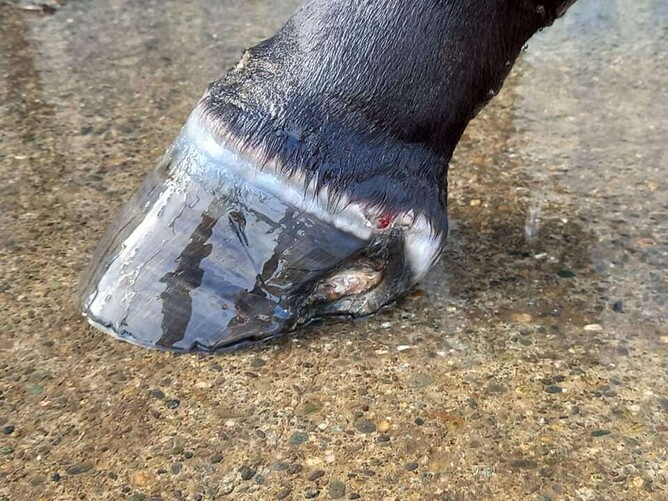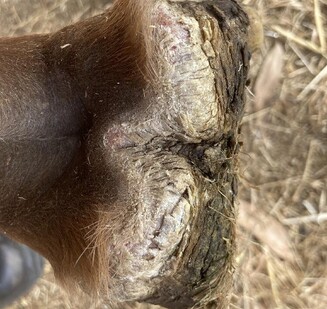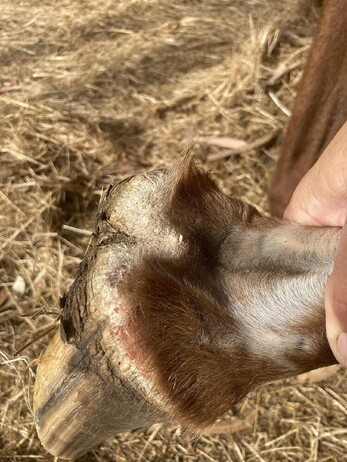The coronary band is the junction between the hair-producing skin of the horse's lower limb and the hoof wall. The coronary epidermis is a lifelong cellular proliferating zone, producing keratinocytes that subsequently undergo maturation and ultimately cellular death, to form the middle horn of the wall. The constant adding of keratinized epidermis at the coronary segment causes the middle layer to continuously move downward, past the distal phalanx to reach the ground surface. Average hoof growth is 6 to 8mm/month and is influenced by intrinsic and extrinsic factors. Whole body vibration increases hoof growth during its application with no enduring effect following discontinuation of the modality.
Coronary Band Injuries
We regularly see injuries to the coronary band both from fence/wire injuries and from overreaches. Deep lacerations of the coronary band can result in disruption to the hoof wall horn and the development of deep cracks. If the hoof is imbalanced, the cracks may become destabilized, causing pain and lameness. Treatment of coronary band wounds requires initial wound care and stabilization of the foot, including removal of avulsed (torn away hoof wall) and restricted exercise. The placement of a bar shoe is often required to keep the hoof wall stable until sufficient hoof wall grows down. Occasionally, dremeling out a crack and lacing it with wire plus filling it with hoof ‘bog’ will be required to stabilise it further. Of course, deeper foot injuries also carry the risk of involving deeper structures such as the coffin joint, collateral cartilages or tendon sheath.
Coronary Band Dystrophy
The dry summer weather can catch us out when it comes to some subtle clinical signs involving the hoof wall. A typical case is one of our very own Vet’s horses. This 25-year-old Thoroughbred mare was shod until approximately 5 years ago due to having typical flat thoroughbred feet. After this, she has been regularly trimmed. During wet periods and the winter, the mare is stabled, however, during summer, she is on pasture turnout 24/7. Following a small injury in the fence in December 2021 which resulted in abrasions to the heel bulbs and a pastern laceration, it was noticed that flakey skin over the coronet and heel bulbs was developing. This failed to resolve with the regular application of hoof oil. Further investigation revealed marked hyperkeratosis (callus like development) over the central sulcus of the frog, lamination of the hoof wall at the heels and continued flaking of the coronet, (which when removed revealed serous ooze and haemorrhage). These findings were apparent on all four feet. The mare didn’t exhibit any signs of lameness. Blood tests identified normal selenium zinc and copper levels and the horse was fed a balanced diet containing adequate protein and trace elements including biotin and methionine.
The findings described were consistent with Coronary Band Dystrophy (or more appropriately termed pemphagus coronitis), an immune mediated condition that affects the coronet. The histological findings are similar to pemphigus foliaceus. Treatment is often palliative rather than curative and involves ensuring the foot is well balanced, removing all roughened surfaces of the frog and hoof wall using a hoof rasp and medium grit sandpaper and applying a combination of ‘Sorbeline’ and corticosteroid creams to the coronet along with oiling the hoof wall on a daily basis. Systemic corticosteroids may also be used in some cases to help reduce inflammation and oozing of the coronet. Failure to treat long standing cases may result in the development of ‘Canker’ or bacterial invasion into deeper tissues resulting in cellulitis.
If you suspect your horse’s hoof growth is abnormal, there is a weakness in the coronary band due to an injury, or your horse’s feet are abnormally cracked and dry beyond what would be normally experienced during our dry weather, feel free to contact us at VetSouth Equine.
- Heather Busby



